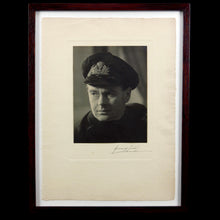Coastal Forces - 1st SGB Flotilla Leader Lieutenant-Commander Peter Scott, 1943
- Regular price
- £950
- Sale price
- £950
- Regular price
-
- Unit price
- /per
Adding product to your cart
Overall: 45cm (17.7in) x 34.5cm (13.5in)
Provenance: Sir Peter Markham Scott (1909-1989)
Silver bromide print. Head and shoulders studio portrait of Lieutenant-Commander Peter Scott in Royal Navy Volunteer Reserve uniform. Studio mounted on textured paper. Signed on the mount in pencil by the photographer ‘Howard Coster / London’. Image: 20.4cm x 15.7cm. Framed and glazed.
Sir Peter Markham Scott CH, CBE, DSC, FRS, FZS (1909-1989) was the son of Scott of the Antarctic and his artist wife Kathleen, Lady Kennet. Educated at Oundle and Trinity College, Cambridge, he studied art at the State Academy, Munich and at the Royal Academy Schools, London. He was a yachting enthusiast and won a sailing bronze at the 1936 Berlin Olympics. By the time war broke in 1939, he was already an established author, broadcaster, artist and conservationist with ornithology at the heart of his interests.
Read more
On 11 June 1940 he went ashore at Saint-Valery-en-Caux as an RNVR sub-lieutenant to help in the evacuate wounded from the 51st Highland Division prior to its surrender en masse to Erwin Rommel next day. He served in the Shakespeare class destroyer HMS Broke supporting the North Atlantic convoys, and in April 1941 was mentioned in despatches for rescuing crewmen from the burning armed merchant cruiser Comorin. He was further credited with designing a ship camouflage scheme for the Western Approaches (MBE, military division, 1942).
In the summer of 1942 he was appointed commanding officer of a new type of Coastal forces vessel, steam gun boat HM SGB 9, later named HMS Grey Goose. Steam gun boats were large enough to withstand rough weather and combined the functions of the motor gunboat (MGB) and motor torpedo boat (MTB) in order to hunt down German E-boats. In August 1942 Scott and SGB 9 gave early proof of the buccaneering spirit for which SGB crews were known when he was again mentioned in despatches ‘for gallantry, daring and skill in the combined attack on Dieppe' (Operation Jubilee).
He subsequently led a number of actions in Grey Goose in the spring and summer of 1943 as Senior Officer, 1st SGB Flotilla operating from HMS Aggressive (the Coastal Forces base at Newhaven). On 1 June 1943 he was awarded the Distinguished Service Cross (DSC) ‘for skill and gallantry in action with enemy light forces’, when he engaged 3 armed enemy trawlers about 20 miles west of Le Havre. 'Many hits were scored on the rear enemy ship, and although she was not seen to sink she was left stopped and silenced and burning. All our ships returned safely to harbour. They suffered casualties, one being killed and 4 wounded.
He was further mentioned in despatches for an action in the English Channel on 26 July 1943, and awarded a Bar to the DSC for actions on 4 and 27 September 1943. By early 1944, the E-boat threat had reduced and he was appointed staff officer operations, coastal forces to help prepare the role of coastal forces in Operation Neptune, the naval element of Operation Overlord, the invasion of France. He was subsequently detached as Staff Officer, Coastal Forces, British Assault Area (Courseulles) and later as Liaison Officer, PT Boats (Cherbourg).
After the war he stood for Parliament but was narrowly defeated. He famously established the Wildfowl & Wetlands Trust in Slimbridge in 1946 and helped found the World Wide Fund for Nature, the logo of which he designed. He was knighted in 1973 for his work in conservation of wild animals and in 1987 he was made a Companion of Honour for services to conservation.
The photographer Howard Sydney Musgrave Coster (1885-1959) was brought up on the Isle of Wight, served in the RAF during the First World War, and spent time in South Africa before opening a London studio at 8 / 9 Essex Street, off the Strand, in 1926. Following the example of the American Pirie MacDonald, he specialized in male subjects and styled himself 'Photographer of Men’ to distance himself from the society portraiture of Bond Street. His business was successful from the start, and by the 1930s, Coster had undertaken several commissions from George V and members of the royal family as well as literary figures, such as Isherwood, Auden and Spender. He famously photographed T.E. Lawrence after a chance meeting on a London street in 1931. Other famous sitters came from the entertainment industry and included Gielgud, Korda, Laughton, and Olivier. In contradiction to his promotional tagline, he also photographed notable women including Vera Brittain, Rebecca West, Radclyffe Hall and Edith Sitwell.
In 1985 the National Portrait Gallery held the retrospective show ‘Howard Coster: Camera Portraits of the Twenties and Thirties’ to mark the centenary of his birth. The accompanying catalogue declared: ‘Coster is perhaps noted for his innovative and dramatic use of lighting. Carefully judged, low-key effects illuminate character and suggest atmosphere in studies … The quality and range of his work in this exhibition confirm Coster as one of the major photographic portraitists of his time.’






